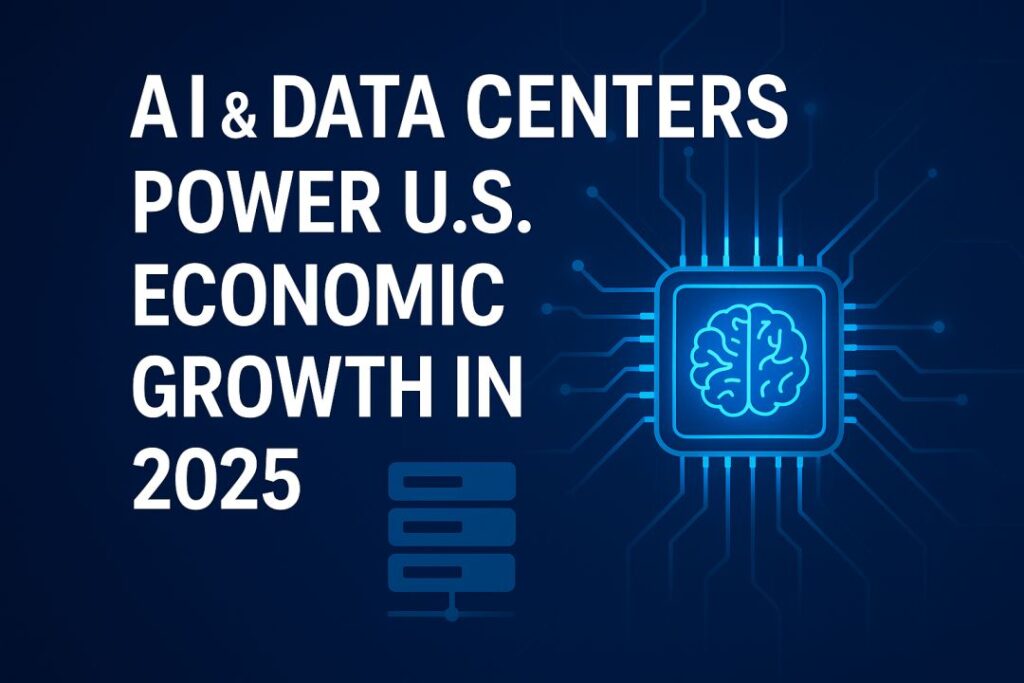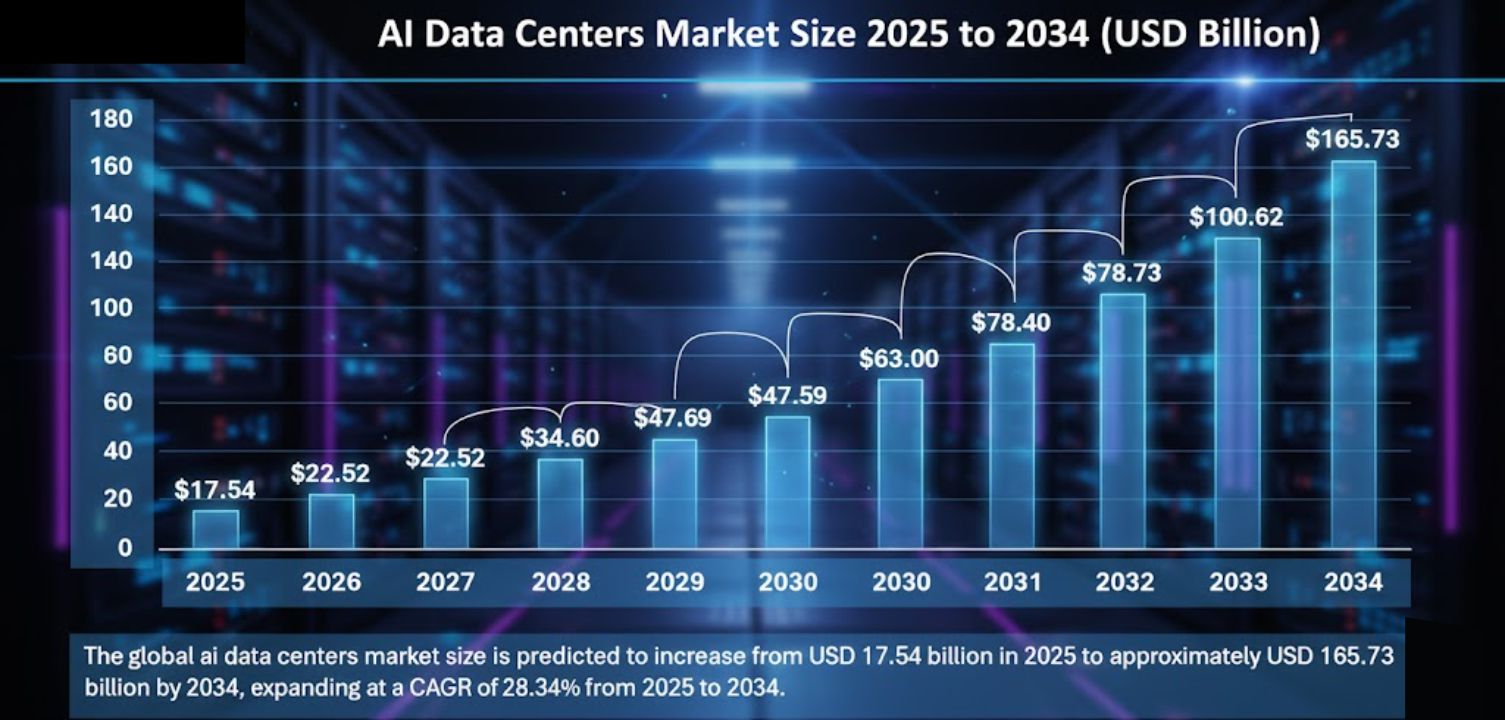U.S. Economic Growth in 2025: Driven by AI and Data Center Investments
The first half of 2025 has marked a turning point in the U.S. economy. For the first time in history, nearly all measurable economic growth has been powered by one force — the technology sector. Specifically, investments in artificial intelligence (AI) systems, data centers, and high-performance computing infrastructure have become the backbone of U.S. expansion.
What was once a supporting industry has become the primary growth engine. Tech spending has now overtaken consumer activity, reshaping how economists measure national output and redefining what drives the modern American economy.
Technology Becomes the Heart of the Economy

Economists analyzing early-2025 data found that without AI and data center investment, the U.S. economy would have seen almost no growth. Traditional sectors such as manufacturing, retail, and real estate contributed little to overall expansion, while technology-related projects accounted for more than nine-tenths of GDP gains during the first six months of the year.
This unprecedented trend demonstrates how essential computing infrastructure has become to the broader economic system. From cloud computing hubs to AI model training facilities, the U.S. has entered a phase where physical and digital infrastructure investments are fueling progress in ways similar to how railroads and highways powered growth in previous centuries.
AI Spending Outpaces Consumer Demand
For decades, the U.S. economy was known for being consumer-driven, with household spending typically making up about two-thirds of GDP. In 2025, that balance has shifted. Business investment in AI and data centers has outpaced consumer demand as the main contributor to growth.
While consumers are still spending, the scale of corporate investment in technology is staggering. Billions are being poured into AI development, cloud servers, and the electrical and cooling systems that support these facilities. The outcome is a rapid industrial transformation that is expanding the digital capacity of the nation while creating ripple effects in construction, energy, and logistics.
The data center boom, in particular, is emerging as the modern equivalent of the manufacturing revolution — except this time, the factories build computing power instead of physical goods.
How AI Infrastructure Is Reshaping the U.S. Economy
1. A Shift in Capital Allocation
Corporate America is redirecting record levels of capital toward digital infrastructure. Major technology companies are leading the charge, but traditional industries are also investing in AI solutions for logistics, supply chain management, finance, and automation.
The trend reflects a broader recognition that computing power is the new currency of competitiveness. Businesses that can efficiently deploy AI and data processing capabilities gain operational advantages that translate into long-term profitability.
2. A New Industrial Revolution
The current wave of AI-driven construction is often compared to past infrastructure revolutions. Just as electricity and railroads transformed the 19th-century economy, data centers and cloud networks are defining the 21st century. Every new facility brings increased demand for engineers, electricians, and advanced manufacturing components, creating a vast ecosystem of secondary growth.
3. The Rise of Hyperscalers
The world’s largest technology companies—often called “hyperscalers”—are investing at historic levels. Their spending on servers, semiconductors, networking, and energy generation has quadrupled in the past few years. Collectively, their capital outlays now approach hundreds of billions of dollars annually, a figure large enough to influence GDP directly.
The concentration of investment among a few giant firms underscores how dependent modern growth has become on a small cluster of powerful companies and their infrastructure networks.
The Numbers Behind the Boom
While technology spending represents only a small percentage of total GDP, its influence is outsized. Economists estimate that tech investments have contributed roughly 90% or more of U.S. GDP growth so far in 2025. Without them, the economy would be nearly flat.
This surge is driven by:
- AI training facilities requiring vast amounts of computing power.
- Cloud infrastructure upgrades to support global digital services.
- Construction of large-scale data centers across U.S. technology corridors such as Northern Virginia, Texas, and the Pacific Northwest.
- Increased energy generation capacity to power these facilities.
- Hardware expansion from chipmakers, server manufacturers, and networking providers.
These combined investments are now contributing about one full percentage point to real GDP growth, an unprecedented effect from a single industry segment.
Strength Hides Weakness in Other Sectors
Although the overall economy appears robust, much of that strength is concentrated in technology. Beneath the surface, many sectors are struggling.
1. Slower Job Creation
Job growth has cooled in areas outside tech. Retail, manufacturing, real estate, and services have shown little progress, while layoffs continue in sectors affected by automation and cost-cutting. This divergence suggests that economic gains are increasingly capital-intensive rather than labor-driven.
2. Manufacturing and Real Estate Stagnation
Rising costs, high interest rates, and global supply chain adjustments have restrained industrial production and construction outside the data center boom. While thousands of new facilities are being built for AI operations, traditional commercial projects remain limited.
3. Consumer Fatigue
Household budgets remain under pressure from inflation and higher borrowing costs. As a result, consumer spending—the traditional foundation of the economy—has slowed, allowing tech infrastructure to overtake it as the dominant growth driver.
The Fragility of a Tech-Dependent Economy
The growing dependence on AI and data center investments has sparked debate among economists. On one hand, the shift represents innovation and future-oriented capital formation. On the other, it highlights a potential imbalance where too much growth is concentrated in a single sector.
1. Risk of Overconcentration
When an economy relies too heavily on one type of investment, it becomes vulnerable to market corrections. If AI spending slows or investor enthusiasm fades, GDP growth could drop sharply. History has shown that technological cycles—like the dot-com boom or telecom expansion—can swing from rapid acceleration to sudden contraction.
2. Limited Job Multipliers
Data centers, while massive in scale, require relatively few ongoing employees once built. Most of the labor is in the construction phase. As a result, the long-term employment benefits of these investments are limited compared to traditional industries like manufacturing or housing.
3. Energy and Environmental Challenges
AI infrastructure demands enormous amounts of power and cooling. Electricity consumption from data centers is projected to double within the decade. Without corresponding investments in clean energy and grid modernization, growth could face bottlenecks or environmental backlash.
4. Unequal Distribution of Benefits
The geographic concentration of AI and data centers means that growth is not evenly spread. Tech corridors in Virginia, Texas, Oregon, and California are thriving, but many rural and industrial areas are not experiencing the same economic lift. This uneven distribution can widen regional disparities and deepen social divides.
The Debate: Sustainable Growth or Digital Bubble?
Economists remain divided on whether this boom represents healthy modernization or a risky overreliance on technology.
Optimists argue that AI investment is a foundation for future productivity. Every dollar spent on computing capacity today could yield years of efficiency gains across multiple industries. They see the data center surge as a long-term bet on innovation, much like the electrification and internet revolutions.
Skeptics, however, warn that not all AI spending creates real economic value. Some fear overbuilding—where companies race to expand capacity faster than demand warrants—leading to oversupply and financial strain. They caution that growth numbers may look strong now but could mask underlying fragility if consumer sectors don’t recover.
A Broader Economic Puzzle
Despite booming capital expenditure, many households and workers still feel stagnant. Real wages have barely risen, and the benefits of AI-driven productivity have yet to filter down to the average consumer.
Part of the reason lies in corporate behavior. Many businesses are offsetting rising costs by cutting labor and narrowing profit margins instead of raising prices. This strategy keeps inflation in check but suppresses wage growth and job creation. Meanwhile, the high-tech sector’s automation tools further reduce the need for human labor in several industries.
This dynamic creates an unusual economic paradox: strong national output coexisting with weak personal prosperity.
Long-Term Implications: The Next Economic Frontier
1. Productivity Revolution
If AI delivers on its potential, the long-term benefits could be transformative. Enhanced logistics, faster research, automation in healthcare, and smarter energy systems could all raise efficiency and lower costs. In that scenario, today’s data center boom would be remembered as the infrastructure phase of a decades-long productivity revolution.
2. Global Competitiveness
By leading in AI infrastructure, the U.S. positions itself at the forefront of the next global industrial wave. Nations that build and control computational capacity will dominate future innovation. America’s current momentum could help secure technological leadership for years, provided it continues to expand power generation and supply chain resilience.
3. Energy and Sustainability Opportunities
The energy demands of AI also create openings for renewable power and grid modernization. Investments in clean energy, smart transmission lines, and carbon-neutral data centers could make the tech boom more sustainable while addressing environmental challenges.
4. Policy and Workforce Adjustments
Policymakers will need to address the imbalance between capital growth and labor opportunity. Upskilling programs, STEM education, and digital infrastructure initiatives can help ensure that the economic benefits of AI reach a wider portion of the population.
Regulatory clarity around AI use, data privacy, and energy consumption will also play a vital role in guiding sustainable growth.
Can the U.S. Maintain This Growth Model?
The question isn’t whether AI and data centers can keep fueling expansion—it’s whether the rest of the economy can catch up. A healthy economy requires balanced contributions from consumers, labor, and industry. If too much weight falls on one sector, resilience weakens.
To maintain momentum, the U.S. must:
- Diversify sources of growth beyond technology.
- Modernize its power grid to support expanding data centers.
- Encourage innovation in manufacturing, logistics, and healthcare.
- Strengthen consumer confidence and purchasing power.
If these measures align, AI infrastructure could form a sustainable foundation for a new era of productivity. If not, the nation risks depending too heavily on a volatile tech cycle.
FAQs: U.S. Economic Growth in 2025 Powered by AI and Data Centers
1. What is driving U.S. economic growth in 2025?
The U.S. economy’s 2025 growth is largely driven by massive investments in artificial intelligence (AI) and data center infrastructure. These sectors have become the backbone of GDP expansion, overshadowing traditional growth drivers like consumer spending.
2. How much of the U.S. GDP growth is linked to AI and data centers?
AI and data center investments accounted for nearly all U.S. GDP growth in the first half of 2025, contributing up to 90% of total economic expansion, according to leading economists.
3. Which companies are leading AI and data center investments?
Tech giants such as Microsoft, Google, Amazon, Meta, and Nvidia are spearheading the AI revolution. Their combined investments in data center construction and cloud infrastructure exceed hundreds of billions annually.
4. Why are AI and data centers so important for the economy?
AI systems and data centers form the foundation of digital transformation. They power cloud computing, automation, analytics, and emerging technologies—making them critical to innovation, productivity, and competitiveness.
5. What percentage of U.S. GDP does technology investment represent?
Although technology infrastructure accounts for only about 4% of total GDP, it has been responsible for more than 90% of economic growth in early 2025, showing how influential tech spending has become.
6. Is this AI-driven growth sustainable long term?
Experts are divided. While some economists believe this signals a durable shift toward a high-tech economy, others warn that overreliance on one sector could make growth vulnerable to tech market slowdowns or regulatory pressures.
7. How do AI data centers impact job creation?
AI and automation increase productivity but often reduce the need for traditional labor. While tech jobs are booming, other industries like manufacturing and retail have seen slower hiring, creating an uneven labor market.
8. Are data centers contributing to environmental challenges?
Yes. Data centers consume massive amounts of electricity and water, leading to concerns about sustainability. However, many companies are investing in renewable energy and energy-efficient technologies to offset their carbon footprint.
9. How do AI investments affect consumers?
AI-powered systems enhance digital services, improve personalization, and streamline industries from healthcare to finance. However, the economic gains have not yet fully translated into higher wages or reduced living costs for most households.
10. Could the U.S. economy slow down if AI investment decreases?
Yes. Given how much current growth depends on technology spending, a slowdown in AI or data center expansion could expose weaknesses in other sectors and reduce overall GDP growth.
11. What role does government policy play in this trend?
Government incentives, such as AI research funding and infrastructure credits, have encouraged private investment in data centers. Policymakers are now focused on balancing growth with energy sustainability and equitable job creation.
12. How are financial markets reacting to the AI-driven economy?
Investors have shown strong confidence in AI and semiconductor stocks. Companies tied to data infrastructure and cloud computing have seen record valuations, reflecting the market’s belief in long-term AI profitability.
13. What risks are associated with AI-led economic growth?
Major risks include market concentration, energy strain, cybersecurity vulnerabilities, and unequal wealth distribution. Economists caution that unless growth becomes more diversified, the economy could face instability.
14. Will this AI boom improve U.S. global competitiveness?
Yes. The U.S. is reinforcing its leadership in advanced computing and digital innovation, maintaining a significant edge over global rivals in AI research, semiconductor manufacturing, and cloud services.
15. What can businesses and individuals expect moving forward?
Businesses should prepare for increased AI integration across all operations, while individuals can expect new opportunities in tech-related fields such as data science, cybersecurity, and AI engineering. Continuous learning and digital skills will be essential.
Conclusion: The New Engine of American Growth
The first half of 2025 will likely be remembered as the moment the U.S. economy officially entered its AI era. Artificial intelligence and data center infrastructure now define not only the tech sector but the entire direction of national growth.
What began as a specialized area of investment has evolved into the main driver of GDP, innovation, and industrial expansion. Yet beneath the impressive statistics lies a warning — true stability will depend on balance, inclusion, and diversification.
If the U.S. can extend the benefits of AI-driven growth across all sectors while maintaining energy sustainability, it could usher in a new golden age of productivity. But if the boom remains concentrated and unequal, the nation may find itself standing on a narrow foundation of silicon and code.
Either way, one fact is undeniable: in 2025, America’s economy runs on data, powered by the invisible engines of artificial intelligence.

